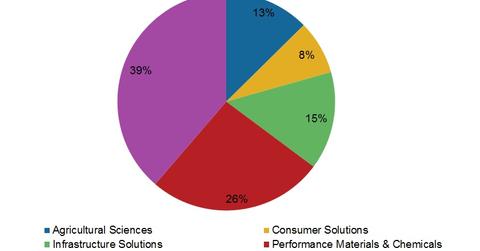Dow: Largest Chemical Company in the United States
The Dow Chemical Company is the largest chemical company in the United States by revenue.
Nov. 24 2015, Published 6:41 p.m. ET

Company overview
The Dow Chemical Company (DOW) is the second-largest integrated chemical player in the world, with a total turnover of $58 billion in 2014. It is the largest chemical company in the United States by revenue. Dow offers a wide range of technology-based chemical products and solutions to various industries such as automotive, electronic appliances, and agriculture. The company has five business segments:
- Agricultural Sciences
- Consumer Solutions
- Infrastructure Solutions
- Performance Materials & Chemicals
- Performance Plastics
The company has more than 200 manufacturing facilities across the globe. The company’s net sales have increased at a steady CAGR (compounded annual growth rate) of 2%, from $53.7 billion in 2010 to $58.2 billion in 2014. Dow’s net income increased by a whopping CAGR of 13% from $2.3 billion in 2010 to $3.8 billion in 2014.
Business history
Dow was incorporated in 1947 under Delaware law and is the successor to a Michigan corporation. In 1897, Herbert Henry Dow founded Dow Chemical in Midland, Michigan. Initially, Dow produced only bleach and potassium bromide. Within 20 years of establishment, Dow had become a leading manufacturer of agricultural chemicals, chlorine, and magnesium metal. Dow has acquired many companies over the last three decades, including Union Carbide Corporation (UCC) for $9.3 billion in 1999, and Rohm and Haas for $15.4 billion in 2008. The company has close to 53,000 employees, around 50% from North America, 25% from Europe, the Middle East, Africa, and India, and 25% from the rest of the world.
The chemical industry is highly competitive and matured. It has been growing at par with the US GDP’s (gross domestic product) growth. Dow produces low-cost performance materials and plastics products, which gives it a competitive advantage over major peers Monsanto (MON), DuPont (DD), LyondellBasell Industries (LYB), and Eastman Chemical (EMN).
Series outlook
In this series, we’ll discuss each of Dow’s business segments in detail, covering geographical exposure, major growth drivers, strategy, major joint ventures, financial liquidity, financial leverage, asset sales, shareholder rewards, and share performance.
The Materials Select Sector SPDR ETF (XLB) largely tracks the performance of major chemical players. The iShares US Basic Materials ETF (IYM) tracks the performance of US-based basic material companies, including chemical companies. Dow forms 11.1% of XLB’s total holdings.
